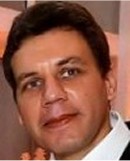|
Plenary
Lecture
Numerical Simulation of Heat and Mass Transfer Problems
of Agroindustrial Interest via Lattice-Boltzmann Method

Professor Jose A. Rabi
Faculty of Animal Science and Food Engineering
University of Sao Paulo - Pirassununga Campus
Av. Duque de Caxias Norte 225, 13635-900, Pirassununga,
SP
Brazil
E-mail: jrabi@usp.br
Abstract: Numerical simulation of food and
bioprocesses has continuously increased not only because
its importance has been recognized but also as suitable
computational tools have been developed and employed.
Accordingly, lattice-Boltzmann method (LBM) has become
an alternative and powerful numerical technique to
simulate a variety of transport phenomena. This lecture
particularly focuses on LBM fundamentals as well as on
its application to problems of agroindustrial interest
involving heat and mass transfer. LBM treats the medium
as a collection of constituent particles occupying and
traveling between a number of lattice sites while
following two computational steps referred to as
“streaming” and “collision”. During the later (which
renders time evolution), particles mutually collide and
are rearranged as they arrive at lattice sites. During
the former (which yields spatial evolution), collision
results are transported to adjacent sites as particles
travel along pre-defined directions. By imposing that
such particle dynamics obey basic conservation
principles while being isotropic, macroscopic medium
behavior can be properly simulated. LBM simulation
results are presented and discussed for processes like
supercritical fluid extraction and biospecific affinity
chromatography in fixed-bed equipment (which evoke
convective-diffusive species transfer besides
sorption-desorption kinetics between solid and fluid
phases) as well as blast-cooling of catering meals
(which involves heat transfers under either zero-order
or first-order modeling with respect to spatial
variation of foodstuff temperature).
Brief Biography of the Speaker:
Jose Rabi received B.Sc. degree in Applied Physics from
the University of Sao Paulo in 1995, M.Sc. degree in
Mechanical Engineering from the Aeronautical Institute
of Technology in 1998 and Ph.D. degree in Mechanical
Engineering from the University of Campinas in 2002 (all
aforesaid degrees in Brazil). In 2003-2004 he joined the
Department of Mechanical and Manufacturing Engineering,
University of Calgary (Canada), as a postdoctoral fellow
and in 2009-2010 he joined the Research Unit for
Refrigeration Process Engineering (GPAN) of CEMAGREF
(France) as a research fellow. From 2002 to 2004, he was
affiliated to the Catholic University of Minas Gerais
(Brazil), mostly teaching Numerical Methods as well as
Transport Phenomena to Civil Engineering undergraduate
courses, and since 2005 he has been a full professor at
the Faculty of Animal Science and Food Engineering,
University of Sao Paulo. His current research interests
include modeling and simulation of agroindustrial
processes, with particular attention to
lattice-Boltzmann methods. He is author of about 30
papers published in international journals and
conference proceedings and also of 2 invited
international book chapters.
|
